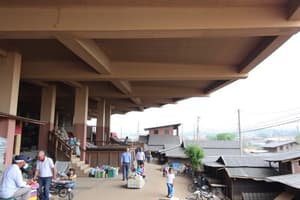Podcast
Questions and Answers
What is the minimum growth rate needed for per capita income (PCY) to rise if population growth is at 2%?
What is the minimum growth rate needed for per capita income (PCY) to rise if population growth is at 2%?
- 3%
- Greater than 2% (correct)
- 2%
- 1%
Which factor significantly contributes to China’s fast growth in terms of its savings-investment ratio?
Which factor significantly contributes to China’s fast growth in terms of its savings-investment ratio?
- Dependence on primary commodities
- High income elasticity of demand
- Low birth rate
- Net savings-investment ratio exceeding 30% (correct)
What is one of the primary consequences of rapid population growth in poorer countries?
What is one of the primary consequences of rapid population growth in poorer countries?
- Reduced congestion
- Decreased pressure on food supplies
- Increase in income per head
- Increased poverty levels (correct)
What is a significant impact of countries that rely heavily on primary commodity exports?
What is a significant impact of countries that rely heavily on primary commodity exports?
Which of the following describes the concept of the 'curse of natural resources'?
Which of the following describes the concept of the 'curse of natural resources'?
What problem is associated with a young age distribution due to rapid population growth?
What problem is associated with a young age distribution due to rapid population growth?
Which of the following is a characteristic of weak institutional structures in underdeveloped countries?
Which of the following is a characteristic of weak institutional structures in underdeveloped countries?
Which phenomenon may arise from an over-valued exchange rate often associated with resource dependence?
Which phenomenon may arise from an over-valued exchange rate often associated with resource dependence?
What is a primary reason that horizontal inequality is viewed as a significant cause of conflict?
What is a primary reason that horizontal inequality is viewed as a significant cause of conflict?
According to the Fisher-Clark thesis, the progression through different economic stages reflects a shift from which of the following?
According to the Fisher-Clark thesis, the progression through different economic stages reflects a shift from which of the following?
Which countries are noted as the only ones having achieved wealth predominantly through agriculture?
Which countries are noted as the only ones having achieved wealth predominantly through agriculture?
What does a poverty-weighted growth rate aim to measure more accurately?
What does a poverty-weighted growth rate aim to measure more accurately?
Newly industrialising countries (NICs) are primarily in which developmental stage?
Newly industrialising countries (NICs) are primarily in which developmental stage?
What is the primary reason that weak institutions in countries like Africa have historical origins?
What is the primary reason that weak institutions in countries like Africa have historical origins?
What major challenge do developing countries face regarding their labor force?
What major challenge do developing countries face regarding their labor force?
Which type of inequality refers to the unequal distribution of income and wealth measured by the Gini ratio?
Which type of inequality refers to the unequal distribution of income and wealth measured by the Gini ratio?
How does vertical inequality change with development according to the Kuznets curve?
How does vertical inequality change with development according to the Kuznets curve?
What proportion of the labor force is either unemployed or disguised unemployed according to the ILO?
What proportion of the labor force is either unemployed or disguised unemployed according to the ILO?
What is a primary driver of unemployment in urban areas of developing countries?
What is a primary driver of unemployment in urban areas of developing countries?
Which of the following is NOT a characteristic of horizontal inequality?
Which of the following is NOT a characteristic of horizontal inequality?
Which of the following is a consequence of poor governance and weak institutions?
Which of the following is a consequence of poor governance and weak institutions?
What is a characteristic of underdevelopment associated with labor productivity in agriculture?
What is a characteristic of underdevelopment associated with labor productivity in agriculture?
Which of the following best explains Engel's Law in the context of developing countries?
Which of the following best explains Engel's Law in the context of developing countries?
What is the required savings-investment ratio to sustain growth of per capita income according to Rostow and Lewis?
What is the required savings-investment ratio to sustain growth of per capita income according to Rostow and Lewis?
What does Kaldor’s growth laws primarily emphasize in economic development?
What does Kaldor’s growth laws primarily emphasize in economic development?
Why is disguised unemployment prevalent in agricultural sectors of developing countries?
Why is disguised unemployment prevalent in agricultural sectors of developing countries?
In the context of structural change, what does 'dominance of agriculture' imply about a country's economic focus?
In the context of structural change, what does 'dominance of agriculture' imply about a country's economic focus?
Which sector shows generally higher labor productivity compared to agriculture?
Which sector shows generally higher labor productivity compared to agriculture?
What does the 'curse of natural resources' refer to in economic terms?
What does the 'curse of natural resources' refer to in economic terms?
What type of inequality is emphasized by the growth and distribution concepts in development economics?
What type of inequality is emphasized by the growth and distribution concepts in development economics?
What is the main function of Kaldor's growth laws in economic development?
What is the main function of Kaldor's growth laws in economic development?
Which of the following is NOT a characteristic shared by poor countries as per the economic framework discussed?
Which of the following is NOT a characteristic shared by poor countries as per the economic framework discussed?
What aspect of productivity does Verdoorn’s Law address in relation to manufacturing growth?
What aspect of productivity does Verdoorn’s Law address in relation to manufacturing growth?
According to Kaldor's 3rd Law, what is the effect of manufacturing output growth on productivity outside of manufacturing?
According to Kaldor's 3rd Law, what is the effect of manufacturing output growth on productivity outside of manufacturing?
What is one primary reason for high levels of unemployment in poor countries?
What is one primary reason for high levels of unemployment in poor countries?
How does Kaldor’s 1st Law describe the relationship between GDP growth and manufacturing output?
How does Kaldor’s 1st Law describe the relationship between GDP growth and manufacturing output?
What role does the state play in accelerating the shift into manufacturing according to development economics?
What role does the state play in accelerating the shift into manufacturing according to development economics?
Which statement accurately characterizes the Fisher-Clark thesis?
Which statement accurately characterizes the Fisher-Clark thesis?
Which of the following is a likely outcome for countries with a 'curse' of natural resources?
Which of the following is a likely outcome for countries with a 'curse' of natural resources?
Study Notes
Characteristics of Underdevelopment
- Agriculture and petty services dominate employment; over 50% of the population in developing countries engaged in agriculture as subsistence or tenant farmers.
- Low capital accumulation due to insufficient savings and investment; needed ratio for sustained growth is over 10% of GDP.
- Rapid population growth more significant in low-income countries (>2% p.a.) than in high-income countries (0.5% p.a.).
- Exports are primarily primary commodities, leading to vulnerability to price volatility and terms of trade deterioration, termed the "curse of natural resources."
- Weak institutional structures hinder entrepreneurship; lack of rule of law and property rights are common issues.
Employment and Unemployment
- High levels of unemployment and underemployment challenge developing countries; one-third of the labor force is either openly or disguisedly unemployed.
- Disguised unemployment manifests in low working hours, especially in agriculture and petty services, where productivity often falls below the poverty line of $1.90 a day.
- Rural-urban migration exacerbates urban unemployment challenges.
Inequality in Development
- Income distribution is highly unequal; measured by the Gini ratio. Vertical inequality measures income disparities, while horizontal inequality addresses discrimination based on race, religion, or gender, often leading to conflict.
- Vertical inequality typically increases with development but eventually declines following the Kuznets curve.
Growth and Development Measurement
- Growth should be assessed not only in overall GDP but also in terms of how benefits are distributed, leading to the concept of poverty-weighted growth rates.
- Inequality can hinder growth through lack of opportunities and poor governance.
Stages of Development and Structural Change
- Rostow identifies five stages of growth: traditional, transitional, take-off, maturity, and high mass-consumption.
- Development entails a shift in resource allocation from primary (agriculture) to secondary (manufacturing) then to tertiary (services) sectors, per the Fisher-Clark thesis.
- Only Australia, New Zealand, and Canada became rich based solely on agriculture; other nations typically industrialize.
Industrialization and Kaldor’s Growth Laws
- A strong correlation exists between manufacturing growth and GDP growth, affirming manufacturing as the "engine of growth."
- Kaldor’s First Law indicates that manufacturing output growth correlates positively with GDP growth; Second Law relates manufacturing output growth to productivity growth in the sector; Third Law connects manufacturing growth to productivity improvements in agriculture.
- Strategies to enhance manufacturing include market versus state intervention, subsidies, and financial incentives.
Summary of Learning Objectives
- Understand shared characteristics of poor countries, including reliance on low productivity agriculture and low investment ratios.
- Recognize principles of vertical and horizontal inequality and the implications for poverty-weighted growth.
- Grasp the significance of institutional frameworks and the role of industry in economic development.
- Familiarity with Rostow’s stages of growth and Kaldor’s growth laws as frameworks for understanding economic development processes.
Studying That Suits You
Use AI to generate personalized quizzes and flashcards to suit your learning preferences.
Related Documents
Description
This quiz covers the characteristics of underdevelopment and structural change, including the dominance of agriculture, low capital accumulation, and rapid population growth. It also explores the dimensions of the development gap, inequality, and poverty-weighted growth rates.



